|
|
|
Sort Order |
|
|
|
Items / Page
|
|
|
|
|
|
|
| Srl | Item |
| 1 |
ID:
144795
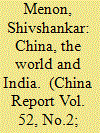

|
|
|
|
|
| Summary/Abstract |
After more than three decades of stupendous growth, China is in the process of making the painful transition to a lower growth path. As it does so, the ruling CPC is increasingly turning to nationalism to provide legitimacy in the eyes of its own people. China now openly seeks to ‘display its prowess’ and ‘assume its responsibilities’ in the world. However, it still lacks the capability to impose a political or security order of its own in its immediate neighbourhood. There is, therefore, likely to be a period of instability in the Asia–Pacific region, and the environment in which India pursues its interests will get more complex. China and India today have a relationship with elements of both cooperation and competition. While both countries have a common interest in improving on the existing security and economic order, they compete in the periphery they share. A danger present in present-day India–China relations comes from the mutual gap between perception and reality. Nevertheless, this article argues that this is a moment of opportunity for India–China relations, and that each country could benefit its core interests by working with the other.
|
|
|
|
|
|
|
|
|
|
|
|
|
|
|
|
| 2 |
ID:
182642
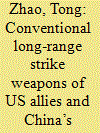

|
|
|
|
|
| Summary/Abstract |
Conventional long-range strike weapons of US allies may exacerbate Chinese concerns about the survivability of its small nuclear arsenal against a precision pre-emptive strike from the US-led coalition, although the degree of the new threat depends on various factors including the numbers and types of such weapons to be deployed. Conventional hypersonic missiles, in particular, may generate acute threat perception, as they can play the role of “door kicker” against China’s so-called anti-access, area-denial capabilities and pave the way for subsequent massive strikes with more traditional weapons. The development of conventional long-range-strike weapons by US allies also affects the risk of conventional conflicts escalating inadvertently to the nuclear level. Such risks are particularly salient in the Asia–Pacific region because of at least two factors: the ambiguous role of Chinese theater nuclear weapons and significant entanglement of conventional and nuclear capabilities at the theater level. Such conventional capabilities of US allies also help shape the region’s overall military balance—something China treats as part of its broader understanding of the term “strategic stability.” Regional players, however, have competing visions about what constitutes a stable military balance. They also have conflicting interpretations of why other parties are pursuing conventional long-range-strike weapons. The development of such capabilities will pose growing challenges to regional strategic stability in the future.
|
|
|
|
|
|
|
|
|
|
|
|
|
|
|
|
| 3 |
ID:
146627
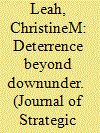

|
|
|
|
|
| Summary/Abstract |
From 1944 to 1973 Australia attempted to acquire atomic weaponry. This ambition was driven by the desire to contribute to defending British interests in Asia, fears of invasion by China, Indonesia, and Japan, great-power war, and the belief that nuclear weapons were merely bigger and better conventional weapons, that they would proliferate, and that US security assurances lacked credibility. Although the pursuit of the bomb was eventually abandoned, this was not the result of US assurances. Rather, geopolitical changes in Australia’s environment meant that a major attack on the continent was unlikely to occur outside the context of a confrontation between the US, China, and the Soviet Union. This article argues that Australia may soon have to rethink its policies towards US extended deterrence and instead focus on developing its own deterrent.
|
|
|
|
|
|
|
|
|
|
|
|
|
|
|
|
| 4 |
ID:
146954
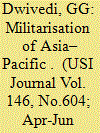

|
|
|
| 5 |
ID:
141277
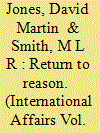

|
|
|
|
|
| Summary/Abstract |
Twenty-first-century political crises stretching from Europe to the Middle East and the Asia–Pacific have undermined the worldview that governed post-Cold War western thinking about a liberal end of history. This worldview assumed that shared norms and transnational institutions would transform the state based-order. In this context, the use of force is considered appropriate only for humanitarian ends meeting a set of predetermined axioms laid down in chapter 7 of the UN Charter. Yet for any strategy to be effective—in an international order subject to change—a clear political aim is required, which might deviate from the general rule. Preoccupied with universal postulates, legal normativism has lost sight of the particular. The argument put forth in this article is that the failure of contemporary western foreign policy in the twenty-first century to address this limitation or to prioritize political ends has led to strategic confusion from Afghanistan to Syria and Ukraine. In this context, it might be useful to reappraise the utility of abstract rationalist approaches to global governance and return instead to an earlier understanding of statecraft that avoided premature generalizations and treated norms as maxims of prudence rather than axioms requiring universal application.
|
|
|
|
|
|
|
|
|
|
|
|
|
|
|
|
| 6 |
ID:
142989


|
|
|
|
|
| Summary/Abstract |
In November 2011, President Barack Obama announced that the United States would rebalance to the Asia–Pacific region. Although this shift had been underway for years, experts across the Pacific generally welcomed Washington's increased attention. From the beginning, however, the U.S. Congress and governments in Asia have questioned whether the rebalance announcement was backed by the necessary resources and implementation strategy.
|
|
|
|
|
|
|
|
|
|
|
|
|
|
|
|
| 7 |
ID:
141748
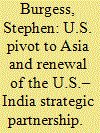

|
|
|
|
|
| Summary/Abstract |
India's national interest has been propelling the country toward becoming a valuable, cooperative partner with the United States. The growing power of China is pushing India to look for partners, especially the United States. The new Indian government, elected in May 2014, is committed to advancing India's national interests and growing India's power as a result of the changing balance of power in Asia. The government has brought a return of nationalism and closer relations with the United States. Therefore, U.S.–India relations are on track to develop more in line with the U.S. vision of an enhanced strategic partnership and an Indian role in the rebalance to Asia. India appears to be more willing and able to be a partner with the United States in the rebalance to Asia, including maintaining security and stability in the Indian Ocean region. To some extent, U.S. activity focused in Southeast Asia will be complemented by India's Look East policy and the U.S.–India Joint Strategic Vision for the Asia–Pacific and Indian Ocean region. There is the prospect of Indo-U.S. cooperation with Myanmar, Vietnam, and other states.
|
|
|
|
|
|
|
|
|
|
|
|
|
|
|
|
| 8 |
ID:
147908


|
|
|
|
|
| Summary/Abstract |
Post-Cold War, balancing theory has fallen on “hard times.” A question of crucial importance for 21st-century peace and stability concerns how Asia–Pacific secondary states are responding militarily to China's rise. China's rapid growth, military modernization, and controversial policies vis-à-vis contested space and territories on its periphery make it a prime candidate for counterbalancing behavior. Yet several recent studies claim that secondary states are accommodating, even bandwagoning with, Beijing. This study challenges these claims, attributing them largely to problematic research designs not uncommon in the wider balancing literature. It proposes a methodological corrective, arguing for widespread employment of an alternative analytical framework relying on clearer definitions and explicitly delineated sets of 21st-century-relevant metrics reflecting the myriad ways contemporary militaries enhance their capabilities in response to perceived threats. Applied systematically to original analysis of the contemporary Asia–Pacific, this framework uncovers what existing studies miss—evidence of practically significant and accelerating balancing against China.
|
|
|
|
|
|
|
|
|
|
|
|
|
|
|
|
| 9 |
ID:
184974


|
|
|
|
|
| Summary/Abstract |
The UN's Women, Peace and Security (WPS) agenda is now over 20 years old, yet much of the Asia–Pacific has been slow to engage in formalized WPS work at national and regional scales. This article examines the relatively recent development of official WPS national action plans by Bangladesh, Indonesia, Japan, the Philippines, South Korea and Timor-Leste, alongside mounting collective efforts towards WPS governance by regional organizations like ASEAN. We demonstrate the existence of an emerging multi-scalar field of WPS discourse and practice in the Asia–Pacific, which is still in its formative stages and carries the potential for both convergence and contestation as actors work to navigate diverse approaches to WPS governance along various ‘tracks’. This article also points to the limitations of a rigidly formalized elite-driven WPS agenda that neglects well-established communities of practice in the Asia–Pacific. Ultimately, more attention needs to be paid to the complex dynamics that shape the ongoing postcolonial encounters between the broader WPS agenda and the localized historical and discursive contexts of regional WPS governance.
|
|
|
|
|
|
|
|
|
|
|
|
|
|
|
|
|
|
|
|
|